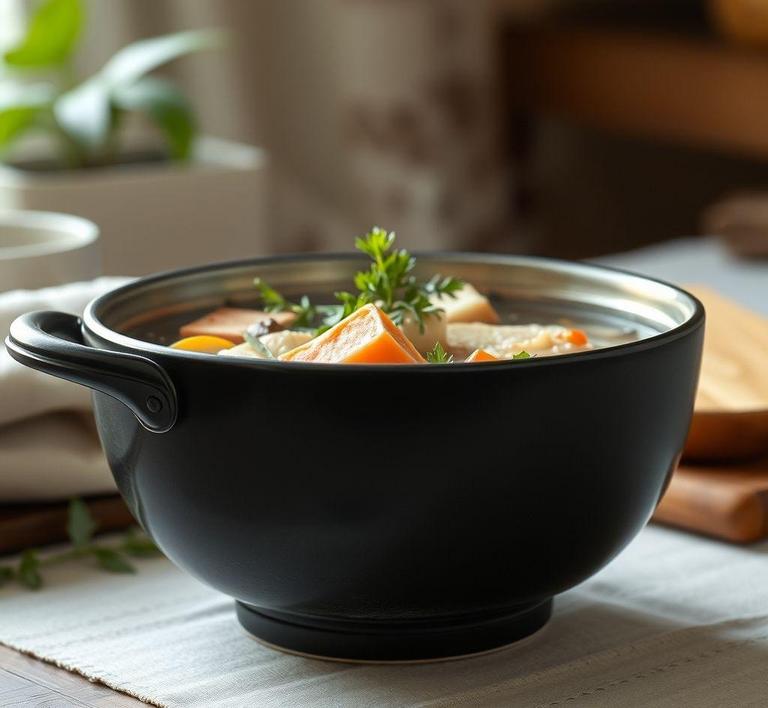If you’ve ever found yourself with leftover broth and wondered whether you can safely refreeze it, you’re not alone! Refreezing broth is totally doable, but there are a few important things to keep in mind to ensure it maintains its flavor and safety. Whether it’s chicken, beef, or vegetable broth, freezing and refreezing can sometimes change the texture and taste, so knowing the best practices for doing it properly will help you avoid any unwanted surprises. In this guide, we’ll dive into the dos and don’ts of refreezing broth, from how to store it to the ideal time frames for reusing it so you can enjoy your homemade creations without worry!
Can You Refreeze Broth?

Broth-whether it’s chicken, beef, vegetable, or any other kind-is one of those kitchen staples that can either be made from scratch or bought pre-made in a store. But what happens when you have leftover broth and don’t know whether you can refreeze it? After all, most of us are familiar with the rule that certain foods, once thawed, should not be refrozen. So, can you refreeze broth, or is it something you should avoid?
The short answer is yes, you can refreeze broth, but with certain considerations. Broth is a liquid, and like many other liquids, it can freeze and thaw without undergoing major changes in its structure. However, the critical factor lies in how the broth was initially frozen and thawed. If you froze the broth properly (in an airtight container, for example) and thawed it in a safe manner (such as in the fridge or using cold water), you can refreeze it without too much concern.
However, once broth has been thawed and refrozen multiple times, the texture, flavor, and overall quality can begin to degrade. This is where the potential problem lies. Refreezing broth isn’t ideal for all situations, especially if it’s been sitting out at room temperature for too long, as bacteria can multiply rapidly and affect the safety of the broth. So, while it’s technically possible to refreeze broth, it’s essential to consider how it was handled before you decide to do so.
How To Refreeze Broth?
If you’ve decided to refreeze your broth, it’s essential to do so in a way that preserves its quality and safety. The steps you follow will make a significant difference in how the broth fares once it’s thawed again.
- Cool the Broth Properly: Before you even think about freezing or refreezing broth, make sure it’s properly cooled. Hot liquids should never be placed directly in the freezer, as they can cause the temperature in the freezer to rise and potentially affect other frozen foods. To cool the broth quickly, pour it into smaller containers or let it sit at room temperature for no more than two hours.
- Use Airtight Containers: The next step is crucial for avoiding freezer burn. Store the broth in airtight containers or freezer-safe bags. You can even consider portioning out the broth into smaller containers so that you only thaw what you need. This also minimizes the risk of multiple thawing and refreezing cycles.
- Label and Date: Always label and date your containers. Broth can stay in the freezer for a long time (typically 3-4 months), but it’s still helpful to know when it was frozen. This ensures that you won’t end up refreezing broth that has already been stored for too long.
- Thaw Safely: When it’s time to use your refrozen broth, thaw it safely. Ideally, thaw it in the refrigerator overnight, as this minimizes the risk of bacterial growth. If you’re in a rush, you can thaw it under cold water or use the defrost setting on your microwave. Avoid thawing broth at room temperature, as this can encourage bacteria to multiply.
- Refreezing After Thawing: If you’ve thawed broth but haven’t used it all, you can refreeze the remainder. However, it’s important to note that the more times you freeze and thaw the broth, the more likely it will lose its flavor and texture. If the broth has been sitting out at room temperature for more than 2 hours, it’s best not to refreeze it due to potential food safety concerns.
Quality Impact
Refreezing broth may not harm its safety when done correctly, but it will inevitably impact its quality. Here are some factors to consider when assessing the potential effects of refreezing broth:
- Texture Changes: One of the most noticeable effects of refreezing broth is the texture. Broth contains water, fat, and various dissolved compounds from the vegetables, meat, or seasonings used in its preparation. When you freeze and thaw the liquid, the water molecules expand and contract, which can cause separation of fats or a thinning of the broth. Repeated freezing and thawing cycles can cause a more pronounced separation of fat and water, making the broth seem oily or diluted when reheated.
- Flavor Degradation: Another impact of refreezing is on the flavor. While broth can remain safe to eat after being frozen and thawed, its flavor can become muted or less complex. Ingredients such as herbs, spices, and vegetables can lose some of their potency after multiple freezing cycles, and the broth may taste somewhat “flat” compared to freshly made broth.
- Loss of Nutritional Value: Although broth retains most of its nutritional content even after being frozen, there may be a slight decrease in certain vitamins, particularly if the broth contains vegetables. Freezing and thawing can cause the breakdown of delicate nutrients like Vitamin C, which are sensitive to temperature changes. This isn’t typically significant enough to make a dramatic difference, but it’s something to keep in mind if you’re using broth for its health benefits.
- Appearance: When thawed and reheated, refrozen broth may not look as clear or smooth as fresh broth. You might notice cloudiness or a layer of fat that has separated, which is a natural byproduct of freezing and thawing. This can be remedied by skimming off the fat when reheating, but it’s a sign that the broth has undergone multiple freezing cycles.
Refreezing broth is possible, but it comes with certain risks and drawbacks. While it is generally safe to do so as long as the broth was handled correctly-cooled properly and stored in airtight containers-the quality of the broth will likely suffer. Refrozen broth may experience changes in texture, flavor, and appearance, and there may be a slight loss in nutritional value.
If you plan to refreeze broth, it’s best to do so in small portions to avoid having to refreeze it multiple times. Always ensure that the broth was thawed safely and hasn’t been left out at room temperature for extended periods. In general, while refreezing broth is not the most ideal way to preserve it, it is a practical option when done with care. Just be prepared for some changes in its quality the next time you use it.
Is It Safe To Refreeze Broth?
Refreezing broth-whether chicken, beef, vegetable, or any other type-can be a topic of concern for many home cooks. The safety of refreezing broth depends on several factors, but in general, it is possible to refreeze broth if done correctly. However, there are important guidelines to follow to ensure both safety and quality.
The primary concern with refreezing broth is the potential for bacterial growth. When broth is thawed, it enters the temperature danger zone (between 40°F and 140°F), which is the ideal range for bacteria to multiply rapidly. If broth is left at room temperature for too long or thawed improperly, bacteria can proliferate, leading to foodborne illnesses. The key is to ensure that the broth is only thawed once, and that it is refrozen within a safe time frame.
Signs That Broth Should Not Be Refrozen
While the idea of saving leftover broth might be appealing, there are certain signs that indicate it should not be refrozen, regardless of how much you may want to save it.
- Extended Thawing Time: If broth has been thawed for more than two hours at room temperature (or one hour in hot weather), it may not be safe to refreeze. This is because the broth could have spent too much time in the danger zone, allowing bacteria to grow. Even if the broth still looks and smells fine, it may harbor harmful bacteria that could cause foodborne illnesses.
- Off Smell or Unusual Color: Broth that has developed an off-putting smell or a color change should be discarded immediately. Fresh broth, when thawed, should still retain its characteristic aroma and color. If these change, it could indicate that the broth has gone bad, even if it hasn’t been left out too long.
- Inconsistent Freezing: If the broth has not been frozen properly-such as being in a container that is not sealed tight, or if there’s visible ice formation on top-this could indicate that air exposure or fluctuating temperatures may have affected its quality. Refreezing in this case would not be advisable.
- Multiple Thawing and Refreezing Cycles: Broth should ideally only be thawed and refrozen once. If you have already thawed and refrozen it once, additional cycles could compromise the flavor and safety of the broth. The more times a liquid is frozen and thawed, the greater the likelihood of bacterial contamination and texture degradation.
Common Refreezing Mistakes
Even experienced cooks can make some mistakes when it comes to refreezing broth. These errors can result in loss of flavor, texture, and-most importantly-safety concerns. Here are some common refreezing mistakes to avoid:
- Refreezing Broth After Thawing at Room Temperature: A critical mistake people often make is thawing broth at room temperature and then refreezing it. This practice can allow harmful bacteria to multiply, even if the broth looks and smells fine. Always thaw broth in the refrigerator or using a cold water bath to keep it out of the danger zone.
- Freezing Broth in Large Containers: Freezing broth in large containers makes it difficult for the liquid to freeze evenly and quickly. The longer the broth stays at unsafe temperatures before it freezes solid, the higher the risk for bacterial growth. Instead, divide the broth into smaller portions before freezing, ensuring a more efficient freeze and quicker thaw.
- Not Labeling Broth Containers: Many people forget to label the containers with the date of freezing. This makes it difficult to track how long the broth has been in the freezer. Freezing broth without knowing its age can increase the chances of keeping it past its safe storage period.
- Not Cooling Broth Properly Before Freezing: It’s essential to let broth cool down before freezing it. Putting hot broth directly into the freezer can raise the temperature inside the freezer, causing other frozen items to thaw, potentially leading to bacterial growth. Broth should be cooled in shallow containers to allow the heat to dissipate more quickly. Once cool, it can then be safely frozen.
- Refreezing with Seasonings and Add-ins: Some people make the mistake of adding herbs, spices, or other ingredients to broth before freezing, thinking it will enhance the flavor. However, some seasonings-especially salt-can alter the texture and taste of the broth after multiple freeze-thaw cycles. Additionally, some ingredients might not freeze well, which can lead to an unpleasant result when the broth is thawed and refrozen.
Tips And Tricks
To refreeze broth safely while maintaining quality, there are several tips and tricks you can implement to make the process smoother and more efficient.
- Use Ice Cube Trays: One clever method for storing broth is to freeze it in ice cube trays. This allows for easy portioning, especially if you just need a small amount of broth to flavor a dish. Once the cubes are frozen, you can transfer them to a freezer bag or container for long-term storage.
- Use Freezer Bags for Flexibility: When freezing large quantities of broth, consider using freezer bags rather than rigid containers. They allow for more flexible storage and take up less space in the freezer. Additionally, freezer bags can be laid flat to freeze, making it easy to stack multiple bags.
- Leave Room for Expansion: Liquids expand when frozen, so always leave some space at the top of the container to accommodate this. This helps prevent the container from bursting and maintains a proper seal on the broth.
- Portion Before Freezing: By portioning the broth before freezing, you avoid the need to thaw an entire batch of broth when you only need a small amount. This also helps with quicker freezing and more consistent thawing. Use small containers or freezer bags to store manageable portions.
- Reheat and Use Quickly: Once you’ve thawed broth, use it within a few days to ensure that it remains safe to consume. If you’re unsure about its quality after thawing, give it a sniff or a taste test before cooking with it.
- Label Your Containers: To keep track of how long the broth has been frozen, always label your containers with the date of freezing. This simple step helps you avoid keeping broth in the freezer for too long.
Conclusion
Refreezing broth can be done safely, but it’s important to follow proper guidelines to ensure both its safety and quality. The risks associated with bacterial growth when thawing and refreezing, combined with changes in texture and flavor, mean that cautious preparation and storage are essential.
Always thaw broth in the refrigerator or using safe methods like cold water baths. Avoid refreezing broth multiple times, and make sure that the broth has not been left at room temperature for extended periods. Proper labeling, portioning, and cooling techniques can help maintain the quality of your broth while allowing you to make the most of your leftovers. By following these tips, you can safely refreeze broth, enjoying it without any safety concerns or loss of flavor.


